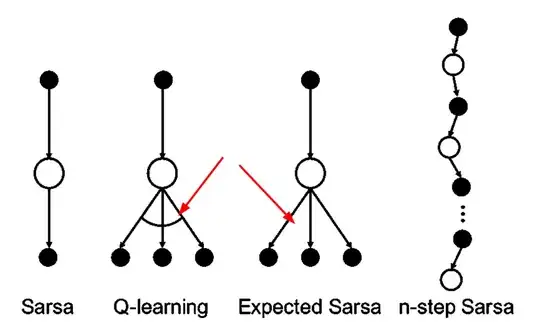I might be blind.
But I wasn't able to find or figure out what the small difference between Q-learn and SARSA depicts in the following image;
 (src).
What does the semi-circle show? and what does the lack of the semi-circle show? I've your eyes with some red arrows.
(src).
What does the semi-circle show? and what does the lack of the semi-circle show? I've your eyes with some red arrows.
- 206
- 1
- 7
1 Answers
It is a reference to the difference between their update rules.
While both are attempting to estimate $Q(S_t,A_t)$ by iterative updates, the formula they use to converge on this value is different.
Expected SARSA uses a weighted sum over the latest estimations of $Q(s_{t+1}, a)$ for all actions in the new state (weights are the probability assigned to taking that action by the policy):
$$ Q(S_t,A_t) \leftarrow (1-\alpha)\cdot Q(S_t,A_t) + \alpha \cdot\left[R_{t+1} + \gamma\sum_a\pi(a | S_{t+1})Q(S_{t+1}, a)\right] $$
Q-Learning uses the maximum expected value over all actions in the new state:
$$ Q(S_t,A_t) \leftarrow (1-\alpha)\cdot Q(S_t,A_t) + \alpha \cdot\left[R_{t+1} + \gamma\max_aQ(S_{t+1}, a)\right] $$
So, to answer directly: the semi-circle represents taking the maximum.
- 148
- 5